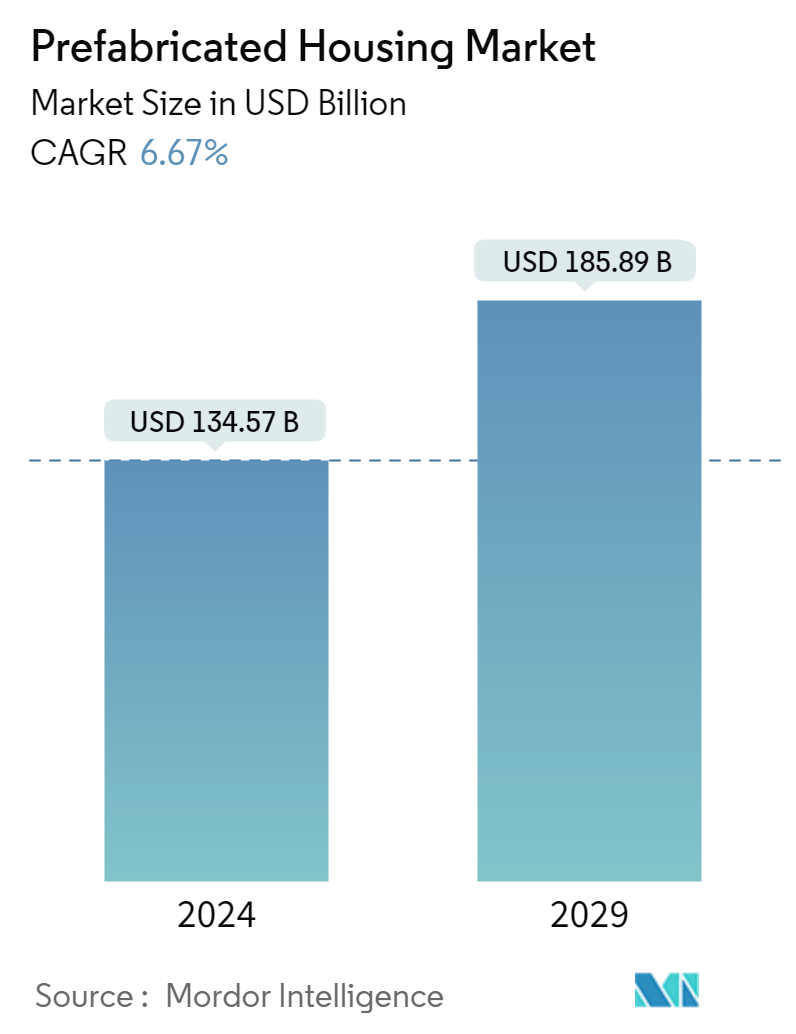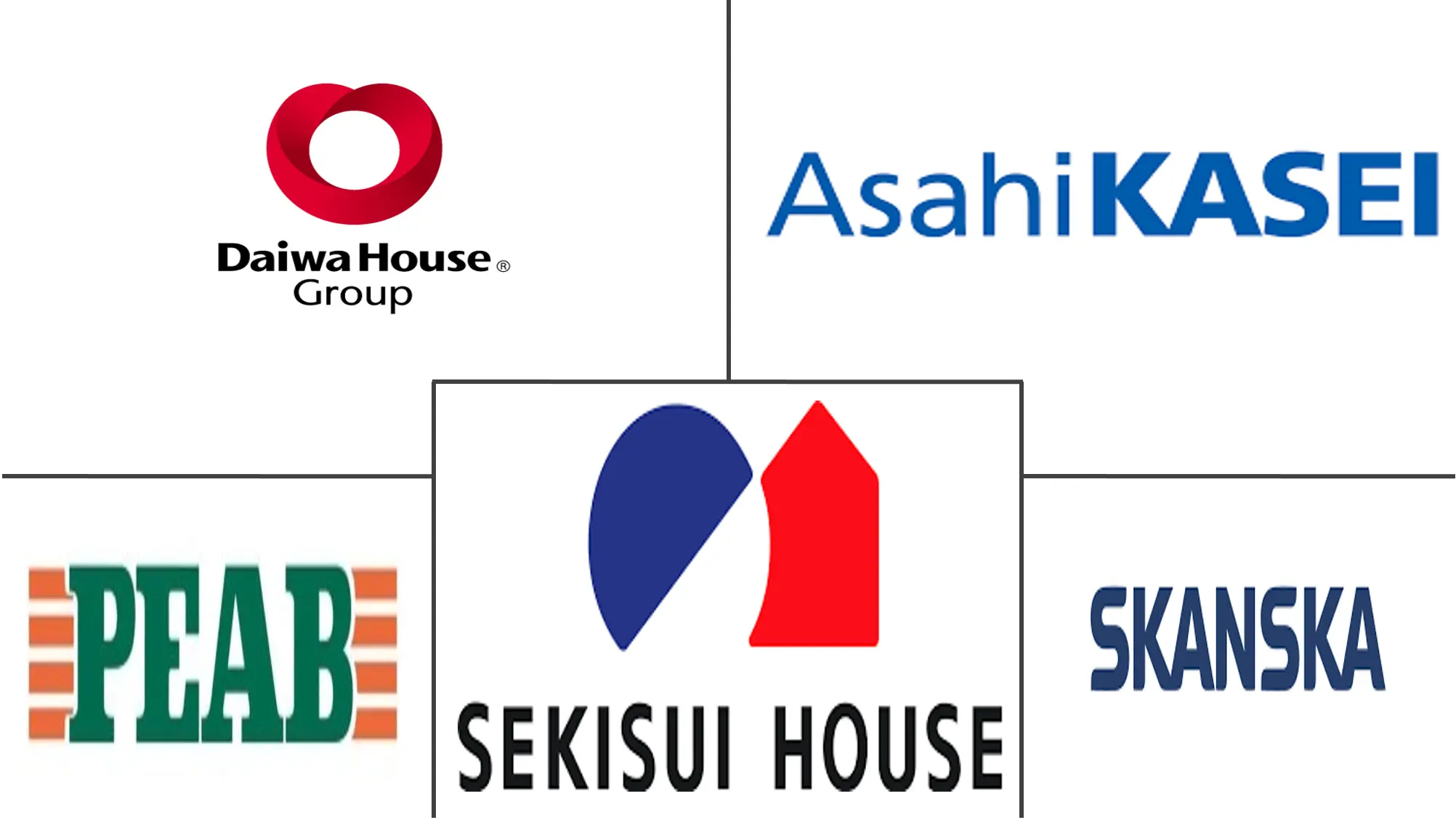Market Size of Prefabricated Housing Industry

| Study Period | 2020 - 2029 |
| Market Size (2024) | USD 134.57 Billion |
| Market Size (2029) | USD 185.89 Billion |
| CAGR (2024 - 2029) | 6.67 % |
| Fastest Growing Market | Asia Pacific |
| Largest Market | Asia Pacific |
Major Players
*Disclaimer: Major Players sorted in no particular order |
Prefabricated Housing Market Overview
The Prefabricated Housing Market size is estimated at USD 134.57 billion in 2024, and is expected to reach USD 185.89 billion by 2029, growing at a CAGR of 6.67% during the forecast period (2024-2029).
The construction industry has also seen delays in finishing projects due to labor shortages and a global supply deficit in several common building materials, including steel, paint, cement, wood, cabinets, and electrical components. Compared to before the pandemic, wait times for building materials have increased by at least double, and in some cases, by more than 10 times. Construction projects will experience completion delays and increased cost pressure due to the unfavorable weather affecting the US East Coast since the start of 2022.
The modular building market is expanding as demand rises, even though it accounts only for a small portion of the USD 1 trillion construction industry. Prefabrication is becoming increasingly popular because of its on-site effectiveness, increased worker productivity and safety, and cheaper construction costs. In addition to these advantages, modular construction offers fantastic prospects for more responsible use of building materials and environmentally friendly designs. It also marks a significant advancement in environmental sustainability.
Not all mobile houses are modular. According to industry experts, 80% of manufactured homes are still at the original location where they were first installed. A manufactured home can be moved for between USD 5,000 and 10,000 or even USD 20,000, depending on the distance, licenses and taxes, and the house size. The US Census Bureau estimates that there are about 7 million prefabricated homes in the country (7.5% of all single-family homes). It is good to see that more than 80% of contractors have already embraced off-site building techniques like modularization.
Due to various causes, including a tight labor market, rising input costs, and increased demand due to government incentives, the construction and building industries have experienced significant price inflation in most US states. However, the problems above are beginning to affect all types of construction. The rise in costs traditionally started in residential construction.
Despite falling demand for housing, Singapore's house prices are still rising. In the first quarter of 2023, national inflation-adjusted house prices increased by 5.59% from a year earlier, following a Y-o-Y increase of 2.05% in Q4 2022, 5.7% in Q3, 3.73% in Q2, and 2.22% in Q1. In the last quarter, real estate prices increased by 1.99% every quarter.
Prefabricated Housing Industry Segmentation
Prefabrication is assembling components of a structure in a factory or other manufacturing site and transporting complete assemblies or sub-assemblies to the construction site. A comprehensive background analysis of the global prefabricated house market, including the assessment of the economy and contribution of sectors in the economy, market overview, market size estimation for key segments, and emerging trends in the market segments, market dynamics, and geographical trends, and COVID-19 impact, is covered in the report.
The global prefabricated house market is segmented by type (single-family and multi-family) and geography (North America, Asia-Pacific, Europe, GCC, and the Rest of the World). The report offers market size and forecasts for all the above segments in value (USD).
| By Type | |
| Single Family | |
| Multi Family |
| By Geography | |
| North America | |
| Asia-Pacific | |
| Europe | |
| GCC | |
| Rest of the World |
Prefabricated Housing Market Size Summary
The prefabricated housing market is experiencing significant growth, driven by increasing demand for efficient and cost-effective construction solutions. This sector, although a small segment of the broader construction industry, is gaining traction due to its ability to enhance on-site productivity, improve worker safety, and reduce construction costs. The rise in popularity of modular construction is also attributed to its potential for sustainable building practices and environmentally friendly designs. Despite challenges such as labor shortages and supply chain issues, the market is poised for expansion, with companies leveraging advanced manufacturing techniques and eco-friendly materials to differentiate their offerings. The market's growth is further supported by strategic collaborations and investments aimed at increasing production capacity and addressing housing shortages in various regions.
Globally, the prefabricated housing market is characterized by its fragmented and competitive nature, with no single player dominating the landscape. Major companies like Daiwa House Industry, Sekisui House, and Skanska AB are at the forefront, employing innovative production technologies to minimize costs and enhance product appeal. The market is also witnessing a surge in demand for project homes and public housing projects, particularly in Europe, where countries like Germany, Austria, and the UK are leading in adoption. In the United States, the persistent housing shortage underscores the need for rapid construction solutions, with prefabricated homes emerging as a viable option. As the market continues to evolve, investments in automated production facilities and regional manufacturing centers are expected to further bolster the industry's capacity to meet growing demand.
Prefabricated Housing Market Size - Table of Contents
-
1. MARKET INSIGHTS
-
1.1 Current Market Scenario
-
1.2 Technological Trends
-
1.3 Insights on Supply Chain/Value Chain Analysis of the Prefabricated Housing Industry
-
1.4 Cost Structure Analysis of the Prefabricated Housing Industry
-
1.5 Impact of COVID-19 on the Market
-
1.6 Insights on Different Types of Materials used in Prefabricated Housing Construction
-
-
2. MARKET SEGMENTATION
-
2.1 By Type
-
2.1.1 Single Family
-
2.1.2 Multi Family
-
-
2.2 By Geography
-
2.2.1 North America
-
2.2.2 Asia-Pacific
-
2.2.3 Europe
-
2.2.4 GCC
-
2.2.5 Rest of the World
-
-
Prefabricated Housing Market Size FAQs
How big is the Prefabricated Housing Market?
The Prefabricated Housing Market size is expected to reach USD 134.57 billion in 2024 and grow at a CAGR of 6.67% to reach USD 185.89 billion by 2029.
What is the current Prefabricated Housing Market size?
In 2024, the Prefabricated Housing Market size is expected to reach USD 134.57 billion.

